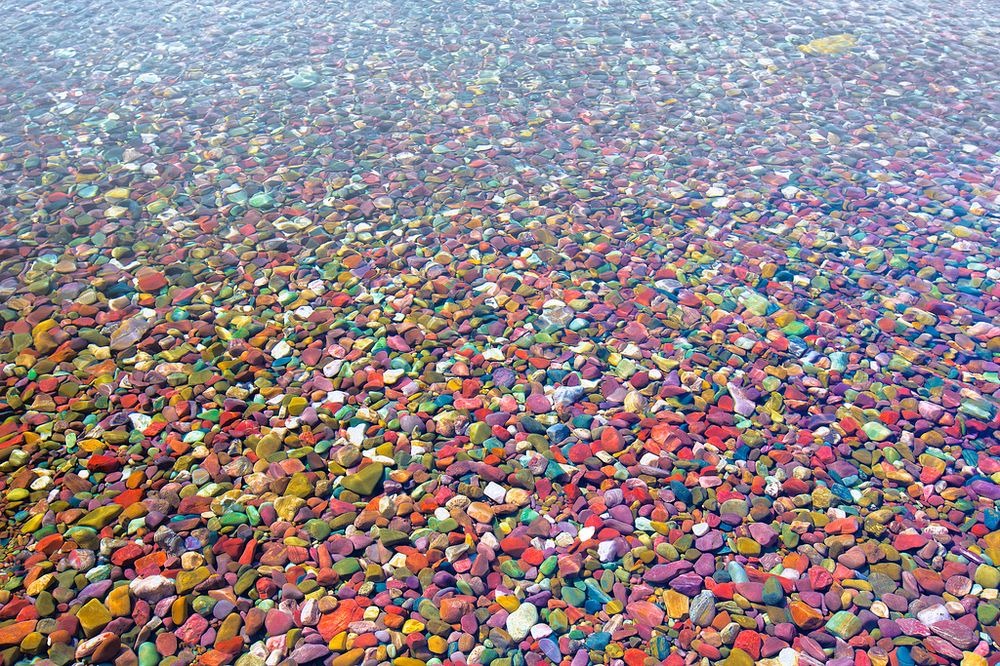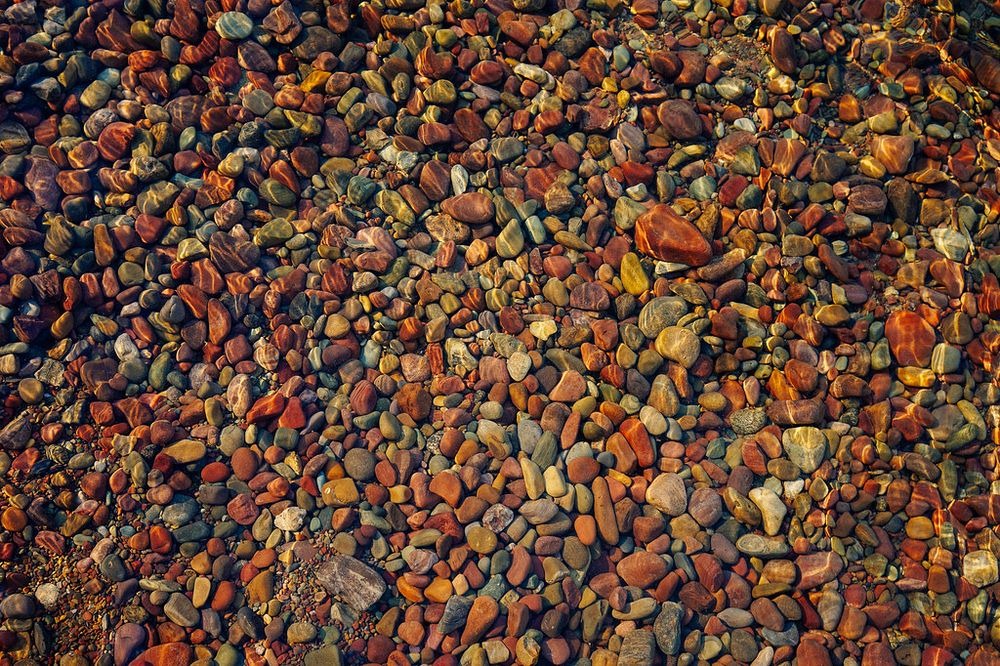The Glacier National Park in the U.S. state of Montana, on the border with Canada, is home to more than 700 lakes, although only 131 of these lakes have names. Approximately 200 lakes are over five acres in size, and a dozen of them exceeds thousands of acres, which in unusual for mountain lakes. Additionally, the waters of the lakes are remarkably clear. This is owning to the year long low temperatures that prohibit the growth of planktons. It is not unusual to see details on the bottom of the lakes at depths of 30 feet or more.
One of the most striking feature of some of these lakes is the presence of a variety of colored rocks and pebbles just below the water surface and on the shores. The rocks range in color from dark red to maroon, and from green to blue. Colored pebbles are seen in abundance on the shores of Lake McDonald on the western side of the park. Lake McDonald is the largest of the lakes of Glacier National Park with a surface area of 6,823 acres. It is also the longest, at over 15 km, as well as the deepest lake at 141 meters.

Photo credit: Jinrui Qu/Flickr
Quoting from the book “Glacier-Waterton International Peace Park” by Vicky Spring and Tom Kirkendall:
The color of the rocks is determined by the presence or absence of iron. The bright red rocks found along the Grinnel Glacier trail were deposited in a shallow ocean environment where the iron was oxidized by the tidal exposure to the air. Rocks with this coloration often have old ripple marks or ancient mud crack lines.
The rich green-colored rocks were formed in deeper water than the red rocks. Although these rocks contain the same quantities of iron-bearing minerals, they did not have the same exposure to oxygen and the amount of oxidization was limited.
The green rocks can be seen at Otokomi Lake, while the dark-colored rocks found at the upper end of Lake McDonald, along McDonald Creek and around Trout Lake are the result of subjecting the red and green iron-rich rocks to heat and pressure.
These rocks are actually all around Glacier National Park, and were formed at different eras. When the glaciers came, it broke down the rocks into tiny fragments and the rivers washed them away. Many of these got deposited onto the lakes and "tarns" —lakes formed by filling the bottoms of ice-scoured amphitheaters. Water erosion then rendered them into smooth pebbles.

Photo credit: Alaina McDavid/Flickr

Photo credit: Robert Shea/Flickr

Photo credit: Cody Wellons/Flickr

Photo credit: Ron Kroetz/Flickr

Photo credit: Mel Green/Flickr

Photo credit: stonecassie/Flickr

Photo credit: dr-scott/Flickr
Sources: www.nps.gov / Wikipedia



will we be able to grab a handful to take home with us?
ReplyDeleteAlways a good call. Yes please take a handful. Leaving a natural resource unmolested is not the America I know.
DeleteWhat are you going to do with these at home? They sell artificial you can buy
DeleteNo take pictures and leave nature where it belongs
DeleteTake a picture of them. Then grab a handful and leave the picture.
DeleteWell, you can make them in jewelry, you can make nice pictures out of them.
ReplyDeleteYou can use them in the back yard for some color.
You can give them away to your children and their friends.
You can arrange them into colored rock bands.
Do a lot of things with them that are not hurtful to other things.
Heltau
It is national park it's against the aw to take them. Just say'n.
ReplyDeleteAre the colorful pebbles and rocks all around the lake? Or are they more focused in one area?
ReplyDeleteTake a picture of it instead and take that home. Then frame it, buy some of the smaller colored rocks that are polished and set them on a shelf just under it to represent the beautiful day you had. Our geological society here sells some phosphorescent type stones with long and short wave black lights and the money goes back into our research and discovery. I'm in NC. It's life dream to make it up and see those you have there!
ReplyDelete